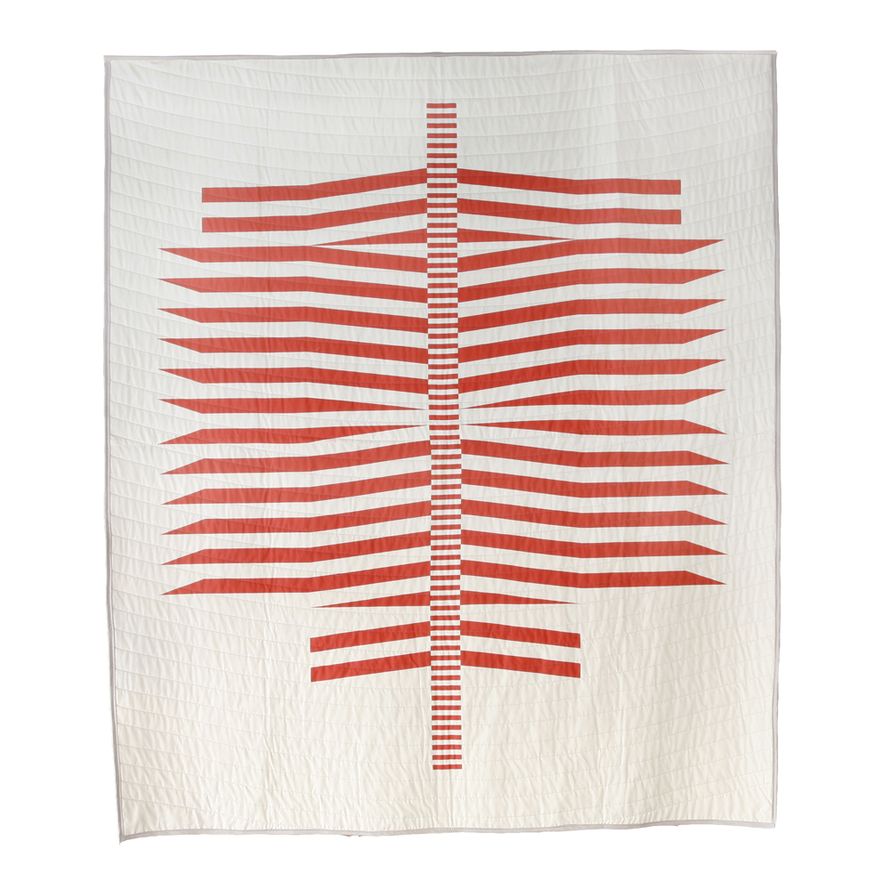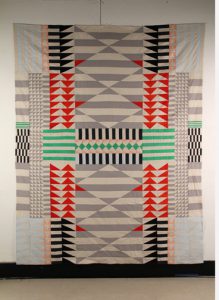
Designer creates quilts with a contemporary look using traditional techniques.
Quilting in early America was far different than it is now. Over the years methods have changed and the invention of the sewing machine has made it easier to create more eccentric designs. In 1976, America celebrated the Bicentennial, which was also a turning point in the history of American quilts in America. The quilt became popular as a means of expressing national pride and achievement, and a powerful reminder of our past.
From this history comes Oklahoma native Meg Callahan. She learned how to sew as a kid and would practice on her mother’s sewing machine. Callahan found joy in being able to make things and wear those items. And she’s mastered the art of patchwork quilting.
After graduating high school, Callahan studied furniture design at the Rhode Island School of Design where she discovered her interest in the art of quilting. “I designed and crafted a quilt for my senior year project and I fell in love with the process and the history behind quilts,” she said in an interview. “It opened up this whole new world for me.”
She started selling her quilts in 2013 when she opened M. Callahan Studio. All the design, fabric dyeing, and patchwork production is done in her Rhode Island studio, and she works with a local artisan who uses a hand-guided long-arm quilting machine to assemble the quilts. Each piece is hand crafted, and has its own unique color, stitching, and details.
“I'm really interested in American craftsmanship—what it meant in the past and what it means today. Quilts are perfect since they play into that theme,” Callahan said. “I think that quilts tend to hold a little bit more meaning because it’s an object that takes time to make. Quilting is precious, and to own an object that you care about, and that has been carefully made by someone creates a really special bond.”
"Being disconnected from the things you surround yourself with to me is a little impersonal and I think if people have more of a connection with the objects they have and they know how the things are made they will have a little bit more respect into the process behind it."
Callahan’s quilts are inspired by the culture and history of traditional American quilting, her home state, and the comforts of home.
“Oklahoma’s landscape is super flat and every day the sky is epic,” she said. “The colors are always changing and the straight line of the horizon play a big part in the design elements. One day the sky could be subtle and peaceful and then the next day there is this intense sunset. Those colors inspire me.”
Callahan now resides in Seattle, Washington where she works as a production manager for BLK Pine Workshop, a Made in America bag company. All of their bags and personal accessories are designed, patterned, and tested within the company’s studio. BLK’s products are individually hand-crafted by artisans with a long history of American production. That’s clearly important to her.

“I think the U.S. has such a rich manufacturing history it is almost shocking that everything is almost completely wiped out,” she said. “Lives were built around manufacturing and now that has completely changed.
“Being disconnected from the things you surround yourself with to me is a little impersonal and I think if people have more of a connection with the objects they have and they know how the things are made they will have a little bit more respect into the process behind it. Having a connection to the maker will always be a little bit more meaningful to people. It’s nice to know that you are contributing to society.”
In addition to Callahan’s own business, she also does work for a few other Made in America companies.
O&G Studio: Founders Jonathan Glatt and Sara Ossana met over ten years ago as graduate students at the Rhode Island School of Design, where Jonathan studied jewelry and metals and Sara studied interior architecture. Flashback to 2009, when Jonathan and Sara returned to their common passion for furniture and household items to launch O&G. The duo look towards the rich history of American design traditions for inspiration. All O&G designs are designed and manufactured in their combined studio, showroom, and workshop in Warren, Rhode Island.
Lotuff Leather: Founded by brothers Joe and Rick Lotuff, and built upon generations of American manufacturing tradition, Lotuff’s fine leather goods are crafted in a family-run workshop on the Connecticut coast. “Manufacturing here is incredibly important and personal to me, said Joe Lotuff. “Learning a craft, from leatherwork to boatbuilding to plumbing, is a path to a satisfying and fulfilling life. Those with decades of experiencing mastering the craft now work shoulder to shoulder with younger folks eager to learn the skills and work with their hands.
“It gives us hope that handcrafted goods is not a dying industry. In fact, it is worthwhile and sustainable enough to continue on for years.”
To view more quilts created by Meg, visit her website http://megcallahan.com/.
